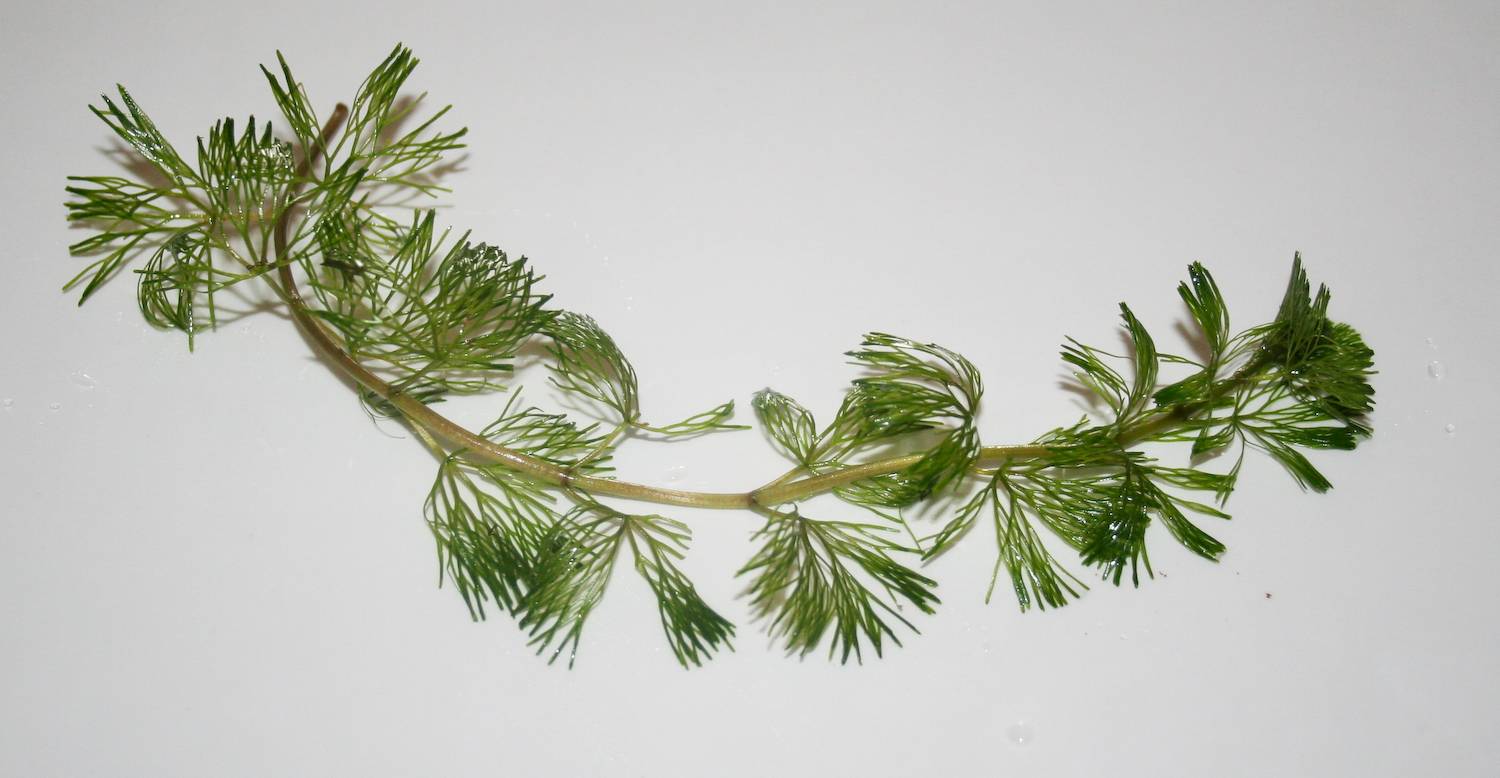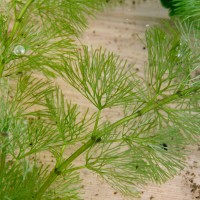
Carolina Water-shield - Cabomba caroliniana
Expand and collapse the sections below by clicking on the title or + / - icons.
Short description of Cabomba caroliniana, Carolina Water-shield
Fanwort is a perennial aquatic plant with opposite, dissected submerged leaves, laminar floating leaves and solitary white emergent flowers, resembling plants of Ranunculus subgenus Batrachium although they have three petals and three sepals.
Impact summary: Cabomba caroliniana, Carolina Water-shield
None known.
Habitat summary: Cabomba caroliniana, Carolina Water-shield
The population in the Forth and Clyde Canal was associated with a heated water inflow and died out when this inflow ceased. The population in the Basingstoke Canal is not associated with heated water and occurs with a diverse native flora.
Overview table
| Environment | Freshwater |
|---|---|
| Species status | Non-Native |
| Native range | Northern America, Brazil, Argentina Distrito Federal, Paraguay, Georgia, Uruguay |
| Functional type | Land plant |
| Status in England | Non-Native |
| Status in Scotland | Non-Native |
| Status in Wales | Non-Native |
| Location of first record | v.c.99 |
| Date of first record | 1969 |
Origin
It is most likely that both GB populations of fanwort involve material from the eastern United States.
First Record
Fanwort was first recorded in the Forth and Clyde Canal in 1971.
Pathway and Method
It was almost certainly introduced by dumping of aquarium contents (the canal also supported goldfish).
Species Status
Fanwort is not spreading rapidly in GB, it is present at single sites in Belgium, Canada, Germany, Hungary and New Zealand and in none of these is it spreading rapidly. In the Netherlands, the plant is present in three locations and has become invasive in one of these, apparently benefiting from high nutrient levels. In Australia it is widespread and invasive. It also occurs as an alien in India, Malaysia, New Guinea and Japan.
Dispersal Mechanisms
There is no evidence that fanwort has successfully spread in GB (beyond local spread in the Basingstoke canal), each known population is likely to have resulted from independent introductions.
Reproduction
Fanwort apparently does not reproduce sexually outside its native range. The stems are fragile and it is able to grow from a single node with one pair of leaves, it can also apparently spread from rhizome fragments. It is likely that any reproduction in Britain is vegetative.
Known Predators/Herbivores
None known outside its native range, in its native range, it is eaten by mammals, wildfowl, a number of species of weevil and noctuid Lepitoptera.
Resistant Stages
None known.
Habitat Occupied in GB
Both populations recorded in GB have been in canals. The population in the Forth and Clyde Canal was associated with an inflow of heated water to the canal, where it occurred with Myriophyllum alterniflorum, in the Basingstoke Canal it occurs with a wide range of aquatic and marginal plants, including Elodea nuttallii, Phalaris arundinacea, Ricciocarpos natans, Sagittaria sagittifolia and Sparganium emersum. It has been suggested that it is dependent upon high nutrient levels and may be out-competed by other species at low nutrient levels.
In GB, fanwort has been recorded from three sites. Between 1969-71 it occurred in the Forth and Clyde Canal, but it died out when a heated water inflow was stopped. It has been known from the Basingstoke Canal since 1990 where it has spread approximately 20km. There is a third unconfirmed record from Connah's Quay (Flintshire) in 2009.
Environmental Impact
Fanwort is highly competitive and can block sunlight to the exclusion of other submerged plants, as well as preventing germination of seed. It can also obstruct movement of animals within water bodies. When dense mats decay this can cause dissolved oxygen depletion killing fish and other aquatic organisms. It has also been shown that fanwort has allelopathic qualities, inhibiting germination and growth in some aquatic species.
Health and Social Impact
Decay of dense beds of fanwort can cause foul-smells. Dense growths can impede swimming, boating, fishing and other water-based recreation as well as degrading the aesthetic and scenic qualities of sites.
Economic Impact
There is no evidence of any economic impact of fanwort in GB. In Australia, the trade in aquatic plants represents a $300,000 a year but conservative (1999) estimates place the national cost of fanwort control at more than $500,000. Wild rice production (Zizania palustris L.) in Canada could be affected by fanwort. Dense infestations can degrade aesthetic and scenic qualities of sites, directly influencing tourism and real estate values, as well as obstructing drainage, navigation and water-borne transport, compromise water storage capacity and taint drinking water supplies.
Identification
Lansdown, R.V. (2009) A field guide to the riverine plants of Britain and Ireland. Ardeola, Stroud, Gloucestershire.
Stace, C.D. (2010) New flora of the British Isles. Third Edition. Cambridge University Press, Cambridge.
Biology, ecology, spread, vectors
European and Mediterranean Plant Protection Organization Data sheets on invasive alien plants: 06-12971 Cabomba caroliniana (www.eppo.orgQUARANTINEias_plants.htm).
Preston, C.D., Croft, J.M. (1997) Aquatic Plants in Britain and Ireland. Harley Books, Colchester.
Management and impact
European and Mediterranean Plant Protection Organization Data sheets on invasive alien plants: 06-12971 Cabomba caroliniana (www.eppo.orgQUARANTINEias_plants.htm).
General
European and Mediterranean Plant Protection Organization Data sheets on invasive alien plants: 06-12971 Cabomba caroliniana (www.eppo.orgQUARANTINEias_plants.htm).
Preston, C.D., Croft, J.M. (1997) Aquatic Plants in Britain and Ireland. Harley Books, Colchester.
Alert status
Carolina Water-shield, Cabomba caroliniana is an Alert Species
Find more information about this alert and the full list of alert species.
Spotted this species?
Distribution map
View the Distribution map for Carolina Water-shield, Cabomba caroliniana from BSBI

Native range map
View an interactive native range map for Carolina Water-shield, Cabomba caroliniana
Risk assessment
Risk assessment for Cabomba caroliniana. See a full list of non-native species Risk assessments.
ID Sheet
ID Sheet for Cabomba caroliniana . See a full list of non-native species ID Sheets.
Legislation
Carolina fanwort, Cabomba caroliniana, is:
- A Species of Special concern
- Listed under Schedule 9 of the Wildlife and Countryside Act 1981
Read more about Non-native species legislation.



__FillMaxWzIwMCwyMDBd.jpg)
__FillMaxWzIwMCwyMDBd.jpg)